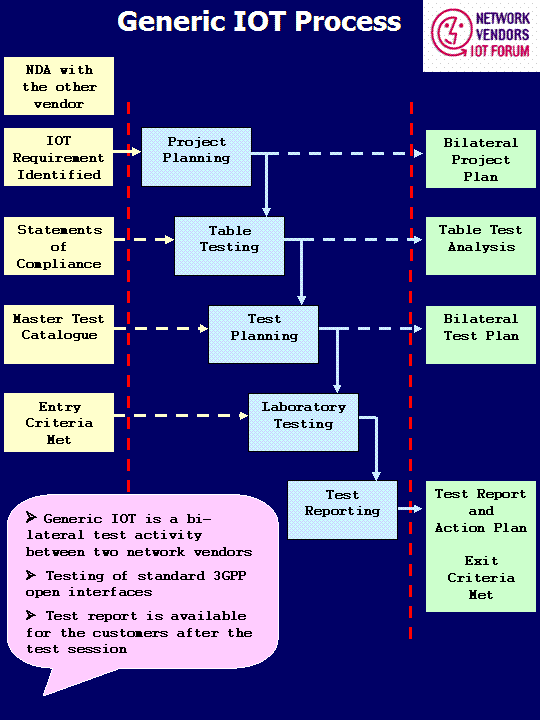| The IOT Process |
Overview IOT Definition Testing Environment & Scope The IOT Process
Interoperability
testing allows vendors to bilaterally verify the standards compliant interfaces
between their network elements in a controlled environment using suitable test
cases prior to software release in common operator networks.
IOT is defined as the
bilateral activity between two vendors verifying an interface between their
network elements, on a functional level, in accordance with the relevant
standards.
The purpose of IOT is to verify network element SW version interoperability from a generic point of view, with relevance to several operator multi-vendor networks.
The
elements under test will be regarded as black boxes with well-defined external
interfaces. Primarily, the correct behavior of an element at its external
interface will be tested.
The
tests are typically performed between vendor test laboratories using co-located
equipment only if necessary.
By
necessity real network elements, mobile stations and applications are used.
Conformance, mobile station, application, performance and stress testing is
outside the bounds of IOT. In fact conformance testing and the necessary
integration of mobile stations and applications used during testing is seen as
internal testing and as such is a pre-requisite to IOT. The mobile stations,
applications and other necessary network elements used during testing are only
seen as tools to verify the interface under test.
In addition, integration and acceptance testing are not seen as part of IOT, as these are seen as operator network specific activities where the system is optimized to give the best performance.
The industry widely adopted IOT process defined by the NVIOT Forum is applied by the vendors for each bilateral test session and consists of five main activities: project planning, table testing, test planning, laboratory testing and test reporting as depicted in the following diagram.

This is the first phase of the IOT process. Once the need for IOT has been identified the vendors shall bilaterally agree on a project plan to cover the testing. The outcome of this shall be a project plan that contains details of the software loads to be tested, testing schedule and any other project specific information required.
Back to The IOT Process
Back
to Top
This phase of the IOT process is where the vendors try to identify any potential problem areas prior to the actual testing. To achieve this the vendors shall exchange their statements of compliance to the relevant standards for the interface under test. The vendors shall then check the statements of compliance in order to identify differences between the implementations that could cause interworking problems, and any functional limits that can influence the test case planning. The outcome of this shall be a table test analysis that is used as a reference for the test planning.
Back to The IOT Process
Back
to Top
This phase of the IOT process is
where the tests to be performed are bilaterally agreed by the vendors. The
references for this phase are the outcome of the table test analysis and each
vendors supported feature set.
Using the above references, a list of test cases shall be prepared for the relevant interface. Once all the tests have been agreed a joint test plan shall be produced. This will form the basis for the laboratory testing.
Back to The IOT Process
Back
to Top
This phase of the IOT process is where the actual testing takes place. Laboratory testing should only start once all the entry criteria have been met.
Verification of the test cases will be achieved by closely monitoring the protocol interworking at the interface under test. A two-step verification scheme will be used: firstly the monitored interworking will be checked against the interworking described in the test case; secondly the functionality described in the test case will be verified.
Back to The IOT Process
Back
to Top
On completion of testing a joint
test report shall be produced and bilaterally agreed by the vendors.
If there are any outstanding issues from the laboratory testing, vendors shall agree on an action plan to cover them.
If all the exit criteria have been met then testing shall be deemed complete.